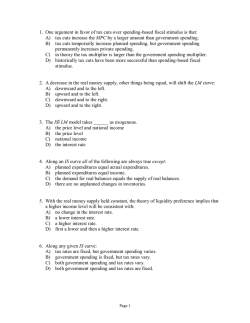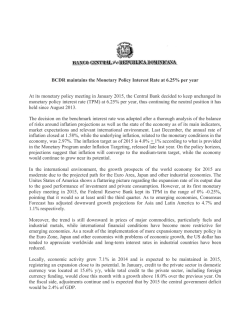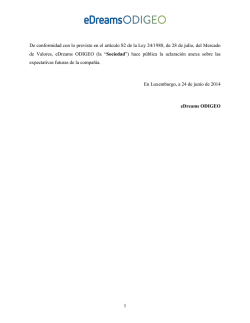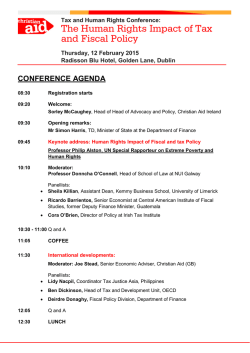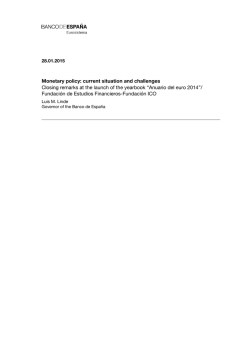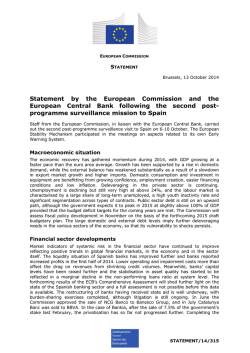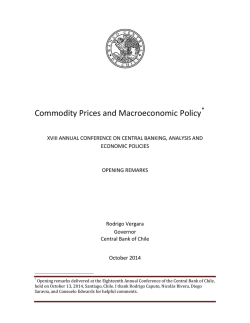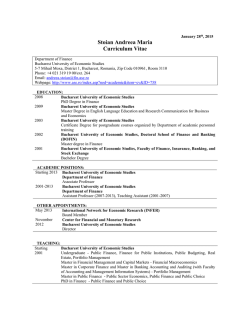
Benoît Cœuré: Lamfalussy was right
Benoît Cœuré: Lamfalussy was right – independence and interdependence in a monetary union Speech by Mr Benoît Cœuré, Member of the Executive Board of the European Central Bank, at the Lamfalussy Lecture Conference, organised by Magyar Nemzeti Bank (the central bank of Hungary), Budapest, 2 February 2015. * * * Summary Decision-makers in different policy areas act independently and are at the same time interdependent. Managing interdependence requires strong framework: “monetary dominance” is the framework in the euro area in which the central bank acts in independence and fiscal policies are constrained in the SGP. The crisis in Europe has shown that policy interactions can be more subtle and involve also financial and structural policies. Monetary policy becomes more effective in impacting the real economy if other policies act in support. If not, it has less impact and expansionary policy has to last longer. An example for interdependence between monetary and financial policies (micro level) is if supervisors show too much forbearance to undercapitalized banks, central bank funding may end up being used to fill the gap. Fiscal policies can also become overburdened if they need to smoothen the economic cycle and at the same time stabilize the banking sector. Banking union has been there one answer to the crisis. European supervision helps align the governance of the financial sector with the aims of monetary policy. And the resolution leg creates rules that limit the link between fiscal policies and the banking sector; bail-in replaces bail-out by governments and taxpayers. The interaction between structural reforms and fiscal policies is clear: if product and labour markets are resilient and flexible, there is less need for fiscal intervention. Constantly refining fiscal rules while leaving structural policies at the national level makes little sense. If fiscal policies are to be freed from structural dominance, strong framework for both is needed. Today structural reforms are their own reward. Tomorrow sovereignty over structural reforms should be shared between countries, allowing for symmetric risk sharing. *** Ladies and gentlemen, Let me begin by reiterating my appreciation for receiving the award in honour of Alexandre Lamfalussy, and my pleasure to be here in Budapest today. What I want to talk about this morning is a theme in which Lamfalussy himself took great interest, which is the interaction between policies in the euro area. In fact, in the Delors Committee, where he was an independent expert, Lamfalussy was one of the foremost proponents of the view that policy interactions in a monetary union had to be governed by a proper framework, and not just left up to ad hoc coordination and market discipline.1 My main argument today is that Lamfalussy was right – and in more ways than even recognised. A monetary union creates complex interactions which have to be governed by a strong and comprehensive framework. Many of these interactions we have only really 1 James, H. (2012), Making the European Monetary Union, p. 248. See also Maes, I. (2011), “The evolution of Alexandre Lamfalussy’s thought on the international and European monetary system”, National Bank of Belgium, Working Paper Research, No. 217. BIS central bankers’ speeches 1 understood thanks to the crisis. And in crucial areas, such as structural policies, we have still not adequately responded. Independence and interdependence between policies In any polity there is always a tension between economic policies. On the one hand, decision-makers in different policy areas act independently. But on the other, they inevitably have to take into account what the others are doing – they are interdependent. This is an inherent struggle which, if left to itself, can produce outcomes that no party really wants. For example, central bank independence is a necessary condition for monetary policy to focus on its core price stability mandate. It is an essential feature of Europe’s constitutional order and puts the onus on governments not to intervene in the policy-making, management and budget of central banks, including in those countries which have not yet adopted the euro, such as here, in Hungary. But independence is not a sufficient condition to ensure that monetary policy calls the shots, as we know from literature on monetary and fiscal dominance.2 Essentially what this literature finds is that if fiscal policy is not constrained by a rule which ensures the sustainability of debt, the central bank is ultimately forced into inflationary policies. At the same time, inflation can make output stabilisation through fiscal policy less effective, as workers’ expectations adapt and prices rise faster than incomes. So all parties lose out. The conclusion is that managing interdependence requires a strong framework. Policymakers must decide which aims they want to prioritise and construct a set of rules which promotes that and sets incentives right. In the euro area, we consciously built our framework around “monetary dominance” – ensuring that the central bank could pursue price stability unconstrained by fiscal considerations. We did this by giving full independence to the central bank, while constraining fiscal policies through the rules of the Stability and Growth Pact, and now of the Fiscal Compact. One can debate the details of this framework, but on its own terms it succeeded: in no cases have fiscal policies caused the central bank to lose its price stability focus. Take the example of the ECB’s recent decision to extend its asset purchase programme. This has been taken in full independence to achieve our medium-term price stability mandate. And in our decision, we have taken into account the specificities of the euro area, meaning that we operate in an environment of decentralised national fiscal authorities, and the ECB has no mandate to engage in large scale pooling of fiscal risks. But we have also learned from the crisis that policy interdependence has different dimensions. There are more subtle interactions between policies than our framework initially acknowledged. And these involve not just monetary and fiscal policies but financial and structural policies as well. What is at issue is not the classic idea about one policy causing another to lose focus on its mandate. It is ex post coordination failure, where some policies miss their mandate, causing others to do more precisely to be faithful to their own – what one might call “weak dominance”. For example, if financial supervisors do not encourage a fast and efficient clean-up of bank balance sheets, central banks’ interest rate cuts are less likely to be passed on to 2 2 The classic reference is Sargent, T., and N. Wallace (1981), “Some unpleasant monetarist arithmetic”, Federal Reserve Bank of Minneapolis Quarterly Review, vol. 5. See also the discussion in Leeper, E. (1991), “Equilibria under “active” and “passive” monetary and fiscal policies”, Journal of Monetary Economics 27, p. 129–147. BIS central bankers’ speeches entrepreneurs. And this is exactly what we saw in the euro area until the Single Supervisory Mechanism was decided. And if at the same time governments do not make it easier to open a new business, those entrepreneurs are less likely to ask for a loan and take advantage of those low financing costs. And this is also what we have seen. In short, monetary policy becomes more effective in impacting the real economy if other policies act in a supportive way; and if they do not, it has less impact and expansionary policy has to last longer to fulfill the mandate. So, “weak dominance” is essentially about whether policies complement or compensate for each other. And what determines this is the framework – whether it is strong enough to ensure the right policies dominate, and whether comprehensive enough to achieve that along all the relevant dimensions of policy interaction. While such a framework is important in any country, it is even more important in a multicountry union. In a single country coordination and policy adjustments involve a single treasury and economics ministry. But in a monetary union there are multiple different policymakers and policies to align. A strong framework that constrains discretion is therefore indispensable. Fiscal dominance Though there is much that can be said about how fiscal dominance in this context, I have discussed this elsewhere.3 The risk of “weak” fiscal dominance was actually recognised by Lamfalussy. He noted that the lack of an appropriate aggregate fiscal stance for the euro area could lead to monetary policy having to bear too much of the adjustment burden: “The combination of a small Community budget with large …. national budgets leads to the conclusion that, in the absence of fiscal coordination, the global fiscal policy of the EMU would be the accidental outcome of decisions taken by Member States. ... As a result, the only global macroeconomic tool available within the EMU would be the common monetary policy implemented by the European central banking system.”4 There is much to learn from this comment. But in the remainder of my remarks I would like to focus on two other areas where we learned important lessons from the crisis for our future framework: financial policies and structural policies. Financial dominance For financial policies – that is, the governance of the banking sector – we saw clearly during the crisis how a weak framework can allow weak forms of dominance to take hold. Both monetary and fiscal policies can have their choices constrained by so-called “financial dominance”.5 For monetary policy, the problem stems mostly from inadequate supervision. At the micro level, if supervisors show too much forbearance to undercapitalised banks, they can end up effectively shifting the burden onto monetary policy – as when those banks lose access to market funding, or have to pay higher risk premia, they turn to central bank funding 3 See speech by Cœuré, B. on “Outright Monetary Transactions, one year on”, Berlin, 2 September 2013. 4 Lamfalussy, A. (1989), Macro-coordination of fiscal policies in an economic and monetary union in Europe, Collection of Papers. Committee for the Study of Economic and Monetary Union, Luxembourg, 1989, January, p. 101. 5 Financial dominance is not a new concept. An early reference is Fraga, A., I. Goldfajn, and A. Minella (2003), “Inflation Targeting in Emerging Market Economies”, Banco Central do Brasil Working Paper Series, 76, section 4.2.2. BIS central bankers’ speeches 3 to fill the gap. Monetary policy has limited discretion here as it cannot independently judge the solvency of its counterparties – and remember, we have 2194. At the macro level, if supervisory policies allow banks to grow too rapidly, and then deleverage too slowly, it can also push the central bank into doing more.6 Since monetary transmission becomes impaired, the monetary “impulse” has to be strengthened compensate for the diminished “outpulse” coming out of banks. Many of our non-standard measures during the crisis, such as our Long-Term Refinancing Operations (LTROs), have essentially performed this function. Moreover, weak micro-supervision and the resulting high level of non-performing loans can also trigger conflicts with other policy areas. For example, when bad banks or asset management companies are set up to deal with legacy asset problems, as happened for example in Slovenia and Spain, it is essential that the line between the duties of fiscal and monetary authorities is not blurred. Central banking is about providing liquidity for solvent institutions, not about providing capital for insolvent ones. Thus, the capitalisation of asset management companies in any country should preferably be shouldered by the private sector, and if this is not possible, by the fiscal authority. We have also seen in the euro area, however, that fiscal policies can face their own dominance problem related to financial policies. This stems less from supervision than from inadequate resolution frameworks. The key issue is that if national fiscal policies are expected both to stabilise the business cycle and to bail-out the banking sector, incurred and contingent liabilities become unsustainable in a banking crisis. In the euro area the total commitment to bank rescue packages amounted to 26% of 2008 GDP. Thus, fiscal policy can quickly become overburdened as well. And here again, a too weak financial framework can trigger conflicts in other areas. If fiscal policy is forced to contract when it is needed to smooth the cycle, then obviously this will reduce aggregate demand. And insofar as this affects price stability, it has to be compensated for by the central bank. Monetary policy has the duty to respond to fulfil its mandate – as the ECB is doing today. The lesson is that dominance is always a multidimensional problem. There is a triangle of monetary, fiscal and financial policies that requires a strong coordination framework. And the Banking Union has gone a long way to providing this. To begin with, the move to European supervision helps align the governance of the financial sector with the aims of monetary policy – or put differently, it reasserts monetary dominance.7 The European supervisor has stronger incentives to uncover weak banks, which helps reduce the risk of financing so-called “zombie banks”. And it is also able to use macroprudential policies to temper swings in the leverage cycle – for example through the release of countercyclical capital buffers. This means that monetary policy transmission should be more immune from disruption, and interest policy should not be overburdened over the cycle with the objective to avoid and then eliminate asset price bubbles. At the same time, the resolution leg of Banking Union – the Bank Recovery and Resolution Directive and the Single Resolution Mechanism – creates a set of rules that will in principle provide separation between fiscal policies and the banking sector. 6 See for example Brunnermeier, M., and Y. Sannikov (2013), “The I Theory of Money”, mimeo. 7 See speech by Cœuré, B. on “Monetary Policy and Banking Supervision”, Frankfurt, 7 February 2013. 4 BIS central bankers’ speeches Bail-in of private creditors will replace bail-out by governments and taxpayers. And this will in turn mean that the public sector has lower contingent liabilities towards banks, creating more space for fiscal policies to act counter-cyclically alongside monetary policy in a downturn. Structural dominance Nevertheless, the loss of fiscal space that many countries have experienced during the crisis – and the knock-on effects for monetary policy – cannot solely be explained by bank bailouts. As has long been recognised, going back to the literature on optimal currency areas8, there is also an important interaction in a monetary union between fiscal and structural policies at the national level. If an economy has resilient product and labour markets and adjusts more quickly to shocks, there is less need for expansionary fiscal policies. But if inefficiencies are high and the economy adjusts more slowly, fiscal policies need to be more expansionary, and for longer, and this can in turn generate spillovers on other participating economies and on the single monetary policy. To give an example of this interaction, Ireland and Spain were two countries that experienced relatively similar shocks emanating from the financial and construction sectors. Both saw their primary deficits deteriorate by around 13pp of GDP between 2007 and 2009. However, by 2012 Ireland had reduced that deficit by more than 7pp of GDP, whereas in Spain the primary deficit was less than 2pp lower. This certainly reflected stronger consolidation efforts in Ireland as part of its adjustment programme. But it also reflected the faster adjustment in prices and wages in the Irish economy, which helped unemployment to begin stabilising in late 2010, while in Spain it rose until early 2013. Of course many other factors were at play as well, but the point is that economic flexibility matters for the size and duration of deficits. And what this implies is that, if structural reforms do not happen, there can be a form of “structural dominance” over fiscal policies. When a shock hits fiscal policies are forced to do all the heavy lifting to stabilise the economy and, over time, fiscal space becomes progressively exhausted. Indeed, this is one explanation for why the Stability and Growth Pact (SGP) rules have not been as effective as we hoped. There is a correlation between the ease with which countries comply with the rules and their progress on structural reforms. Effectively, through lack of reforms some countries have put themselves in a position of excessive deficit dependence, which then makes the difficulty and costs of meeting their obligations higher. The conclusion, therefore, is that constantly tinkering with our common fiscal rules while leaving governance of structural policies entirely at the national level makes little sense. If fiscal policies are to be freed from structural dominance, then we need an equally strong framework in both domains. And it is fair to say in the EU context that the Macroeconomic Imbalance Procedure (MIP) has less teeth and has not benefited from the same level of ownership and political attention than the Stability and Growth Pact. We could also envisage some complementarities between the two. For example, it does make sense to take into account structural reforms when assessing compliance with the SGP, as the Commission now intends to do.9 This is because structural reforms not only 8 For a review see McKinnon, R. (2001), “Optimum Currency Areas and the European Experience”, mimeo. 9 See European Commission (2015), “Making the best use of the flexibility within the existing rules of the Stability and Growth Pact”, communication to the European Parliament, the Council, the European Central Bank, the Economic and Social Committee, the Committee of the Regions and the European Investment Bank, COM(2015) 12, 13 January. BIS central bankers’ speeches 5 reduce the amount of fiscal space needed for effective stabilisation, but they also increase future fiscal space via higher potential output and hence higher government revenues. However, not all structural reforms are associated with fiscal costs, such as notably product market reforms. And some, like some social security reforms, may actually imply short-term fiscal gains. But most importantly, because we do not yet have a credible framework, we should only take into account reforms once they are implemented, not when they are simply announced – and seek an independent assessment of their cost and GDP impact. These are all reasons for countries to press ahead with building a stronger framework. But above all, in the current situation, structural reforms are their own reward. You may recall the not-so-old debate about introducing reform contracts with financial incentives. Well, those incentives are already there! I have discussed elsewhere how structural reforms make monetary policy more effective in a given country and how they help regain fiscal space.10 Countries that reform now thus effectively receive, in return, a more expansionary monetary policy and a less contractionary fiscal policy. Indeed, our recent decision to expand our asset purchases, together with energy prices and an exchange rate more favourable to growth, have opened a unique window of opportunity for euro area governments to act together, remove structural obstacles to growth, and pull our economy out of the low growth, low confidence trap. In saying this, I am of course aware that structural reforms can have mixed effects on growth and inflation, and in certain situations can impact negatively on both in the short-term.11 But empirical evidence is mixed12 and the balance of effects depends crucially on designing reform packages well.13 And indeed, many of the reforms that are on the table today – such as improving the business environment – have little disinflationary effects but can provide a strong boost to investment demand.14 Looking further ahead, stronger governance of structural reforms is also in the enlightened self-interest of all countries that want to see a deepening of our monetary union. It is now fairly clear that, in the long-term, a Union based on no risk-sharing will be vulnerable economically. Yet we also know that permanent transfers between countries cannot work politically. The only way to resolve this paradox is if, behind the “veil of ignorance”, risk-sharing is symmetric between countries. This is only possible if all countries share sovereignty over structural reforms so that they have equivalent growth prospects and shock absorption capacity. And this will in turn be made even easier if deeper cross-border market integration, starting with an effective Capital Markets Union, reduces in the first place the need to share risk through public balance sheets. 10 For more on how supply-side policies can empower demand-side policies see speech by Cœuré, B. on “Structural reforms: learning the right lessons from the crisis”, Riga, 17 October 2014. 11 For an illustration see Eggertsson, G., A. Ferrero, and A. Raffo (2014), “Can Structural Reforms Help Europe?” Journal of Monetary Economics, 61. 12 Bouis, R., et al. (2012) find only weak evidence that reforms entail short-term losses in aggregate output or employment: see Bouis, R., et al. (2012), “The Short-Term Effects of Structural Reforms: An Empirical Analysis”, OECD Economics Department Working Papers, No. 949. 13 For more on this point, in particular the importance of getting the pace and composition of reforms right, see speech by Cœuré, B., Riga (Op. cit.). 14 A similar argument is made in Fernández-Villaverde, J. (2013), “Discussion of “Can Structural Reforms Help Europe?” by Gauti Eggertsson, Andrea Ferrero, and Andrea Raffo”, Journal of Monetary Economics. Lane (2013) also emphasises the importance of calibration and timing in the reform package: see Lane, P. (2013), “Growth and Adjustment Challenges for the Euro Area”, The Economic and Social Review, Vol. 44, No. 2, Summer. 6 BIS central bankers’ speeches Conclusion This brings me to my conclusion. Alexandre Lamfalussy had great faith in the power of the EU institutional framework to enforce policy coordination and deliver a socially optimal outcome for the monetary union.15 This, the crisis has shown, was overly optimistic. It is clear that the euro area needs stronger rules to regulate the many different forms of policy dominance that emerge due to interdependence. That said, if over time those rules lead to more convergence, and more convergence leads to more common institutions with more common powers, then it may be that we need less rules down the road. This is not because complexity is less, but because a single central bank, a single treasury and a single economy ministry can manage it more effectively. In other words, rules are a means to an end, which is a monetary union that creates jobs and growth in an environment of price stability. And until we decisively deepen our monetary union, they are the only way to achieve it. 15 Lamfalussy believed in particular that this would help address asymmetric adjustment within the monetary union: “If surplus countries can be persuaded to expand their home demand at the same time as the deficit countries deflate their own economy, the balance can be restored without undue damage to the rate of growth of the Community as a whole. We do not know what will be the degree of success achieved by the Community authorities in their co-ordinating activity; but it is certain that the existence of an administrative machinery and of an institutional framework (already successful in other fields) will improve the ability of the area to deal with such problems.” See Lamfalussy, A. (1963), The United Kingdom and the Six. An Essay on Economic Growth in Western Europe, London: Macmillan, p. 131. BIS central bankers’ speeches 7
© Copyright 2026
